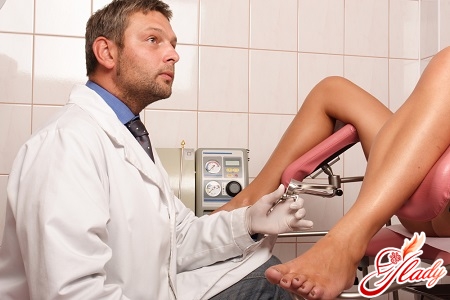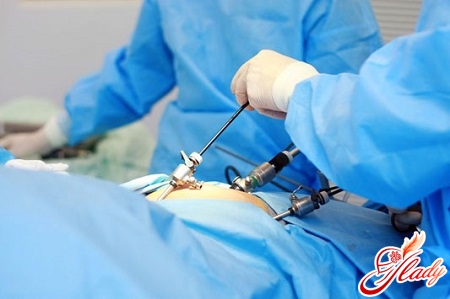
Quite often, women who consult a doctorwith complaints of pain in the lower abdomen, endometriosis is diagnosed. What kind of disease is this, what are its causes, what are the signs of endometriosis of the uterus and how difficult can its treatment be? Today, it is known about endometriosis that this disease is caused by the proliferation of cells of the inner layer of the uterine wall where they should not normally be. The proliferation is cyclical in nature under the influence of the same female hormones that cause monthly bleeding in healthy women of reproductive age - menstruation.
Causes of endometriosis
Genetic mutations andparticipation of cellular enzymes in the process, and hormonal changes in the woman's body. But so far there is no absolutely accurate data on the causes of endometriosis. But it has been established that women of reproductive age from 40 years and older to menopause who have given birth to few or no children are more susceptible to the disease. Approximately 50% of teenage girls who have undergone surgery for pelvic pain were diagnosed with endometriosis of the uterus. Therefore, for your own peace of mind and to avoid the disease, you should listen to the recommendation of gynecologists to visit a doctor for preventive examinations twice a year. The theory of retrograde menstruation (implantation theory) considers the accidental entry of menstrual blood, which inevitably contains uterine epithelial cells, into the fallopian tubes, and from there into the abdominal cavity, as the cause of the disease. Endometrial cells are able to take root in the organs where they get. And then they begin to perform their direct function - grow and prepare for the fertilized egg to fall on their layer. If the fertilized egg does not appear in the uterus, everything is solved in a well-known way - the swollen mucous membrane is rejected, a little blood is released from the damaged vessels - the natural process of menstruation occurs. But stray endometrioid tissues behave in exactly the same way: at the right time they are rejected, but the blood has no outlet and gets into the internal cavities of the body, where it causes inflammation and pain. Irish scientists have discovered a hereditary predisposition to endometriosis. The likelihood of the disease in close relatives is increased by about five times compared to those in whose family women do not face this problem. Therefore, research is being conducted to create a test that would help determine the predisposition to endometriosis and give women at risk the opportunity to follow preventive measures and not get sick. Doctors consider any operations on the uterus to be one of the reasons - abortions, cesarean sections, etc., as a result of which epithelial cells can be carried anywhere with blood. Endometrial cells can even accidentally end up out of place during the intrauterine development of a girl and cause endometriosis in the child or manifest themselves during menarche (the first period). In no case should you blame yourself or allow a man to blame you if the disease does occur. This is just a coincidence, and no one is to blame for this.
Species of endometriosis
Depending on the location of the growing endometrial cells, the disease is divided into: Genital endometriosis:
- Internal - proliferation of the endometrium in the muscular layer of the uterus, in the canal and cervix, in the fallopian tubes;
- External - is localized in the ovaries, vagina, external genitalia, that is, outside the uterus;
Extragenital endometriosis:
- Peritoneal - in the abdominal organs, intestines, bladder, postoperative scars, etc.;
- Extraperitoneal - outside the abdominal cavity, on the extremities, in the lungs, etc.
Symptoms of endometriosis
Various localizations of endometriosis haveits symptoms and treatment. In some cases, a woman may not even suspect that she has the disease and find out about it by accident during a doctor's examination. But some manifestations of endometriosis of the uterus usually make themselves known anyway, and by being attentive to your health, you can consult a doctor for advice and treatment in time. The most characteristic signs of endometriosis are pain of varying intensity and localization. Painful menstruation is a signal that something is wrong in a woman's body in any case. In more than half of patients, dysmenorrhea manifests itself several days before the onset of menstruation (1-5 days), and reaches its maximum on the third day of menstruation. Pain can be caused by the fact that blood from the affected organ flows into the cyst and increases the pressure in it or gets into the peritoneal cavity, causing irritation and inflammation. It may also occur due to an increase in the level of prostaglandin hormones in the blood, which cause vascular spasm, increase uterine contractions, or even due to contact of adjacent organs with the disease site. The intensity may vary - from nagging or aching pain to sharp pains that radiate to the groin area, anus, legs, lower back, etc. After the end of menstruation, the pain either significantly weakens or disappears. Dark brown, brown discharge from the genitals a few days before and after menstruation, possibly during sexual intercourse, should also be a cause for concern. Quite often, they are combined with heavy bleeding during menstruation. About a quarter of patients experience lower abdominal pain without connection with the menstrual cycle. This usually occurs due to the occurrence of secondary inflammation in the organs where endometrial cells have settled. Pain during intercourse occurs when the disease is localized in the vagina, rectovaginal septum, sacrouterine ligaments, etc. Unpleasant sensations during intercourse sometimes force a woman to refuse intimacy with her husband out of fear, which entails additional stress for both. But some or even all symptoms together should not give a reason to independently diagnose endometriosis and treat yourself. They should only be a reason for an immediate visit to the antenatal clinic.
Complications that causes endometriosis
If the presence of the disease is not identified in a timely manner and its treatment is not started, endometriosis can lead to a number of complications associated with the peculiarities of its course:
- Infertility as a result of obstructionfallopian tubes; disruption of the maturation of the egg and its release from the follicle, entry into the fallopian tube and movement to the uterus, attachment of the egg in the uterus and nutrition of the fertilized egg. This can lead to infertility or ectopic pregnancy, early pregnancy loss - miscarriage in the first trimester of pregnancy.
- Due to the compression of nerves with the growth of the endometrium in the organs, neurological disorders may occur.
- Frequent and heavy bleeding leads to anemia - rapid fatigue, shortness of breath and heart palpitations, headaches and dizziness, tinnitus, etc.
- A very serious complication of endometriosis is the degeneration of the overgrown endometrium into a malignant tumor.
How can I diagnose endometriosis?
Diagnostics must be carried outgynecologist after a number of necessary examinations and procedures. Among the examinations, if there is a suspicion, the doctor may prescribe an ultrasound of the pelvic organs, a rectal examination, colposcopy, laparoscopy and hysteroscopy. These procedures are carried out only in clinical conditions, and only on the basis of their data can a specialist draw the appropriate conclusions. There should be no self-diagnosis or referral to healers. The reason for contacting a doctor should be pain in the lower abdomen that has lasted for more than six months. They can intensify in the premenstrual period or during menstruation. There is an opinion of specialists that a uterine inversion predisposes to the disease, so if you have such a diagnosis, you should also more carefully monitor your body, tracking the most minor violations.
Treatment of endometriosis
As soon as the diagnosis is known -endometriosis, - a woman asks a natural question in her condition about the need for surgical treatment. The decision is made by the doctor depending on the localization and severity of the disease. The only effective methods in the fight against endometriosis at the moment are:
- Therapeutic - treatment with hormonal and other drugs;
- Organ-preserving surgery - with removal of only the affected areas (laparotomy);
- Radical surgery - with removal of the uterus and ovaries.
Drug therapy is used in the treatmentendometriosis, the symptoms of which are not expressed or are weakly expressed; for young women who need to restore fertility (the ability to conceive and give birth to a child). Its methods are mainly reduced to hormonal, anti-inflammatory, desensitizing and symptomatic therapy. Of the hormonal agents, estrogen-gestagen agents, progesterone preparations - oral contraceptives and some others are mainly used. Their action is aimed at suppressing the production of female hormones in the body and stopping the processes of the monthly cycle in all tissues of the endometrium, wherever they are located. Such regression of unnecessary tissues occurs only with very long-term use of drugs and requires systematic monitoring by a doctor in case of negative reactions of the body to treatment with contraceptives. Symptomatic therapy involves pain relief to improve the quality of life of patients. Simple analgesics such as paracetamol and non-steroidal anti-inflammatory drugs such as aspirin or ibuprofen are mainly used. New drugs are being developed to improve the effectiveness of therapy and reduce the duration of treatment. New classes of antiprogestogen drugs are better tolerated by patients and have fewer side effects. In case of endometriosis of the external part of the cervix, cryodestruction or electrocoagulation of foci is usually limited, while on the internal part, radiocoagulation or laser vaporization, excision of areas affected by endometriosis may be prescribed. This is also surgery, but it allows you to preserve reproductive functions and avoid removing the uterus. Hormonal therapy is prescribed for up to six months to prevent relapse of the disease. Its goal is to suppress the growth of the remaining cells and cause their death. But in some cases, more complex intervention is required. In case of vaginal endometriosis, excision of the affected areas may be required; adenomyosis of the 1st degree may be limited to removing the damaged area of the endometrium, but in combination with uterine fibroids, complete removal of the organ will be required. But such radical measures are used only when drug therapy is ineffective or when some drugs are intolerant, in especially advanced cases, when the lesions reach more than 3 cm in diameter or lead to disturbances in neighboring organs. Indications for surgery may be progression of the disease after therapy in women over 40 years old. In cases of endometriosis localization in other organs, the decision on treatment methods will require consultations with specialists in the relevant field: urologist, ophthalmologist, surgeon, etc.
Prevention of disease
After the above about surgery atEndometriosis, the recommendations for regular, twice-yearly, preventive examination by a gynecologist no longer seem empty. Detecting the disease at an early stage allows the patient to fully recover, preserve the possibility of a full life for a woman, the ability to give birth to a child. Therapeutic treatment will not require giving up a career or personal life. Women who have not given birth and are 40 years of age and older should monitor themselves most carefully. But girls and young women should also bring this to the attention of their doctor during an examination if they experience pain during menstruation. After any surgical interventions in the uterus, you must carefully follow all the doctor's instructions and not neglect their advice to visit a consultation at the appointed time. A preventive measure can also be called the treatment of any inflammatory diseases in the genital area, even chronic ones, so as not to create the risk of uterine surgery, which can lead to the development of endometriosis. Preventive measures against endometriosis should be paid attention to in the following cases:
- Changing the duration of the menstrual cycle;
- Change in weight, indicating a metabolic disorder;
- The use of contraceptives;
- All women aged 30-45 years;
- Detection of an elevated level of estrogens.
Following simple recommendations and paying close attention to your health will help women maintain health and a full life for many years. Love yourself, be healthy.









